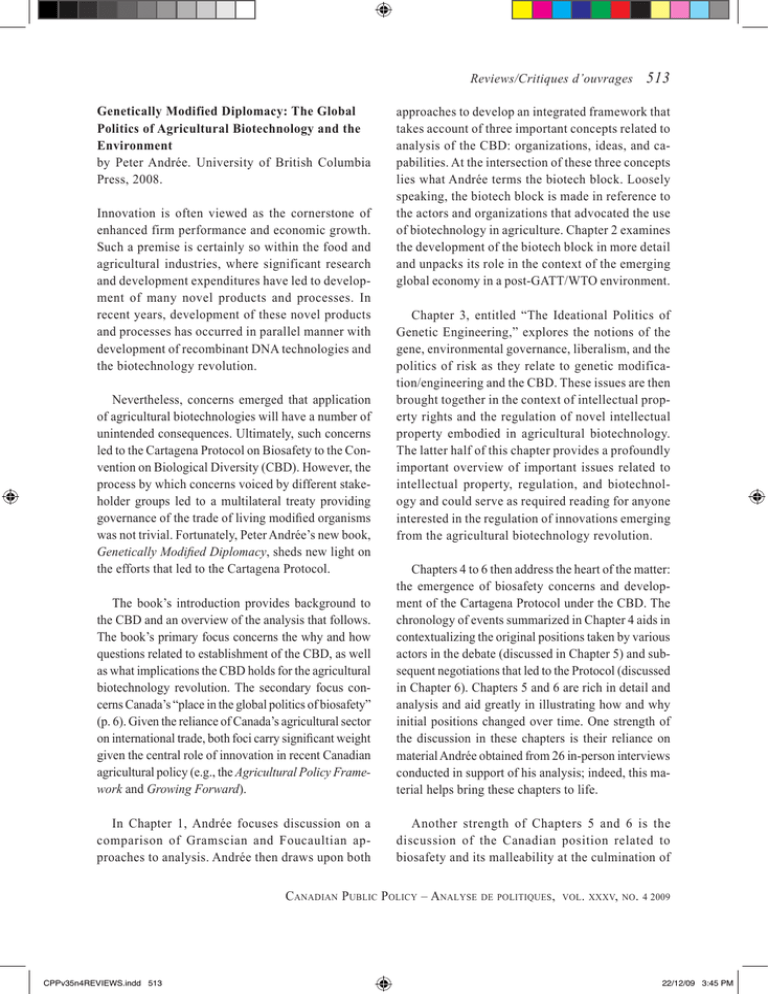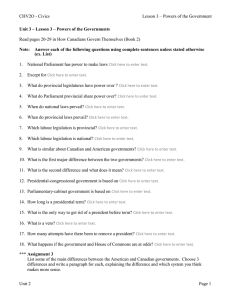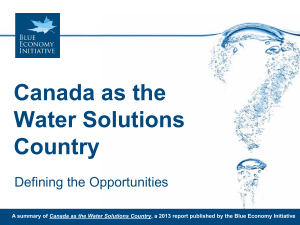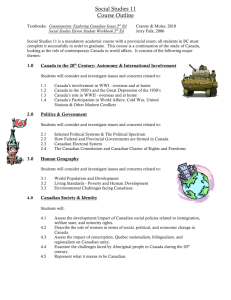513
advertisement

Reviews/Critiques d’ouvrages Genetically Modified Diplomacy: The Global Politics of Agricultural Biotechnology and the Environment by Peter Andrée. University of British Columbia Press, 2008. Innovation is often viewed as the cornerstone of enhanced firm performance and economic growth. Such a premise is certainly so within the food and agricultural industries, where significant research and development expenditures have led to development of many novel products and processes. In recent years, development of these novel products and processes has occurred in parallel manner with development of recombinant DNA technologies and the biotechnology revolution. Nevertheless, concerns emerged that application of agricultural biotechnologies will have a number of unintended consequences. Ultimately, such concerns led to the Cartagena Protocol on Biosafety to the Convention on Biological Diversity (CBD). However, the process by which concerns voiced by different stakeholder groups led to a multilateral treaty providing governance of the trade of living modified organisms was not trivial. Fortunately, Peter Andrée’s new book, Genetically Modified Diplomacy, sheds new light on the efforts that led to the Cartagena Protocol. 513 approaches to develop an integrated framework that takes account of three important concepts related to analysis of the CBD: organizations, ideas, and capabilities. At the intersection of these three concepts lies what Andrée terms the biotech block. Loosely speaking, the biotech block is made in reference to the actors and organizations that advocated the use of biotechnology in agriculture. Chapter 2 examines the development of the biotech block in more detail and unpacks its role in the context of the emerging global economy in a post-GATT/WTO environment. Chapter 3, entitled “The Ideational Politics of Genetic Engineering,” explores the notions of the gene, environmental governance, liberalism, and the politics of risk as they relate to genetic modification/engineering and the CBD. These issues are then brought together in the context of intellectual property rights and the regulation of novel intellectual property embodied in agricultural biotechnology. The latter half of this chapter provides a profoundly important overview of important issues related to intellectual property, regulation, and biotechnology and could serve as required reading for anyone interested in the regulation of innovations emerging from the agricultural biotechnology revolution. The book’s introduction provides background to the CBD and an overview of the analysis that follows. The book’s primary focus concerns the why and how questions related to establishment of the CBD, as well as what implications the CBD holds for the agricultural biotechnology revolution. The secondary focus concerns Canada’s “place in the global politics of biosafety” (p. 6). Given the reliance of Canada’s agricultural sector on international trade, both foci carry significant weight given the central role of innovation in recent Canadian agricultural policy (e.g., the Agricultural Policy Framework and Growing Forward). Chapters 4 to 6 then address the heart of the matter: the emergence of biosafety concerns and development of the Cartagena Protocol under the CBD. The chronology of events summarized in Chapter 4 aids in contextualizing the original positions taken by various actors in the debate (discussed in Chapter 5) and subsequent negotiations that led to the Protocol (discussed in Chapter 6). Chapters 5 and 6 are rich in detail and analysis and aid greatly in illustrating how and why initial positions changed over time. One strength of the discussion in these chapters is their reliance on material Andrée obtained from 26 in-person interviews conducted in support of his analysis; indeed, this material helps bring these chapters to life. In Chapter 1, Andrée focuses discussion on a comparison of Gramscian and Foucaultian approaches to analysis. Andrée then draws upon both Another strength of Chapters 5 and 6 is the discussion of the Canadian position related to biosafety and its malleability at the culmination of Canadian Public Policy – Analyse de politiques, vol. xxxv, no. 4 2009 CPPv35n4REVIEWS.indd 513 22/12/09 3:45 PM 514 Reviews/Critiques d’ouvrages negotiations in Montreal in January 2000. Indeed, it is this analysis and discussion that helps the reader see the process by which policy positions are formulated. Lastly, Chapter 7 provides a synopsis of the outcomes and consequences arising from the Cartagena Protocol. This chapter touches on a number of important aspects related to biosafety, including the SPS Agreement under the WTO and the Codex Alimentarius, as well as how precaution has been viewed from both positive and negative aspects. On balance, this is a thoughtful, well-written book by a promising scholar. Andrée does an exemplary job of illustrating how policy positions are established, and the book provides an excellent example of how initial positions held by stakeholders are malleable in light of disparate positions held by different parties involved in negotiations. And while aspects of the book may not be accessible to those lacking adequate training in political theory, sufficient depth of coverage enables the reader to grasp the main concepts underlying the analysis. A work not mentioned in Genetically Modified Diplomacy that readers interested in the broad subject matter may also find of note is Thomas Bernauer’s book Genes, Trade, and Regulation: The Seeds of Conflict in Food Biotechnology. John A.L. Cranfield, Department of Food Agricultural and Resource Economics, University of Guelph Canadian Public Policy – Analyse de politiques, vol. xxxv, no. 4 2009 CPPv35n4REVIEWS.indd 514 22/12/09 3:45 PM Reviews/Critiques d’ouvrages 515 The Provinces and Canadian Foreign Trade Policy by Christopher J. Kukucha. University of British Columbia Press, 2009. provincial foreign trade policy. Specifically, new and existing norms and standards continue to focus on functional issues and do not directly challenge domestic regulations or judicial precedent” (p. 198). Christopher J. Kukucha’s study provides a sophisticated analysis into the dynamic relationship between the pillars of Canadian federalism and the domestic trade policy process. He carefully integrates varying approaches in the international political economy literature with federalism studies. In doing so, he successfully bridges two areas study that are traditionally considered to be relatively autonomous—international relations and Canadian politics and government. The book is divided into three sections. The first contextualizes the issues under consideration by reviewing provincial trade patterns and the institutional mechanisms in place for consultation among varying interests in the international trade policy process. Part two undertakes a thorough analysis of the processes and outcomes in several respects. As noted earlier, the author undertakes a detailed examination of the role of the provincial executive. He dedicates a chapter to the role of the bureaucrats and legislators in the process, finding that with the exception of Quebec, provincial legislatures play a relatively limited role. Kukucha also examines the role of varying stakeholder and societal interests, noting that the latter has little influence in the process. As significantly, the author evaluates the role of ideas and ideologies on policy-making in this field. Though this is a relatively difficult task, the author does a fine job of exploring this relationship, recognizing that neo-liberalism is only one of a number of considerations that have shaped the issues and outcomes of international trade processes. The last section of the book provides the reader with two sets of case studies that focus on the provincial role in international trade policy. One focuses on the network of relationships among Canadian provinces and American state governments involving functional issues, and the other examines the provincial role in the NAFTA side agreements in labour and environment. The discussion is informative and insightful, providing the reader with a clearer understanding of the nature and limits of provincial governments in the policy area. Kukucha’s study queries the extent to which provinces have been affected by recent international trade agreements given that the substantive issues being addressed increasingly fall within provincial jurisdiction. No longer do tariffs and barriers to trade dominate discussions as trade talks increasingly deal with provincial concerns such as natural resources, labour, and the environment. The book focuses on the effect of this shift in the nature of international trade agreements. As Kukucha indicates, one would anticipate that given the change in the types of issues being addressed, provincial governments would be increasingly involved in the discussions as their politics and local economies would be significantly affected. The book reaches two important conclusions. On the one hand, Kukucha finds that international trade policy remains largely under the purview of federal decision-makers. Although his research carefully reveals that there is a large and relatively institutionalized consultative process, provincial governments play a relatively minor role in agenda-setting or decision-making unless a particular crisis arises (p. 80). On the other hand, Kukucha determines that the country has remained relatively insulated from the new directions of international trade agreements. As he explains, there is “no current evidence of ‘significant’ regime-based change related to The author examines the legal and juridical context for international trade policy issues briefly in Chapter 2. It might have been useful to undertake a more detailed review of the constitutional issues at hand as these might have yielded further insights into why provincial executives and their respective Canadian Public Policy – Analyse de politiques, vol. xxxv, no. 4 2009 CPPv35n4REVIEWS.indd 515 22/12/09 3:45 PM 516 Reviews/Critiques d’ouvrages legislatures are relatively constrained actors in international trade policy processes. The policy implications arising from this work are twofold. First, can the federal government continue to adequately represent the interests of Canadians in international trade matters that fall within provincial jurisdiction? While it seems that the system has promoted Canadian interests relatively well in the sense that the new international agreements have been limited in their influence, can this continue? Second, is the marginalization of societal actors in the making of international trade policy one that can or should be continued? Do these movements or groups have more to bring to the table and, if so, should they be better incorporated into the trade policy process? Overall, this is an excellent analysis that will be required reading for federalism and public policy scholars alike. J acqueline D. K rikorian , Department of Political Science and Law and Society Program, York ­University Canadian Public Policy – Analyse de politiques, vol. xxxv, no. 4 2009 CPPv35n4REVIEWS.indd 516 22/12/09 3:45 PM Reviews/Critiques d’ouvrages Fixing the Future: How Canada’s Usually Factious Governments Worked Together to Rescue the Canada Pension Plan by Bruce Little. Toronto: University of Toronto Press, 2008. Bruce Little tells an interesting policy story. Although the primary focus of the study is the Canada Pension Plan (CPP), it encompasses the wider Canadian retirement income system of general revenue and earnings-based public pensions and private pensions or retirement savings. This is essentially a financial study, and as an economics analyst and advisor, Little has presented a balanced financial and legal account. Fortunately for the reader, as a journalist he has also enlivened it with the social and political struggles embedded in the story. In other words, he has saved the rather dry subject matter with good storytelling. The book is replete with behind-the-scenes stories and telling quotes. It is an enjoyable read. Little’s subtitle signals his intent in presenting one of the few successful cases of extensive intergovernmental collaboration in Canada on a complex and politically difficult policy file. Beginning with the events of the 1960s, which led to the creation of the CPP (and sister Quebec Pension Plan), the author lays out the federal-provincial intergovernmental dynamics that resulted in the overhaul of the CPP in the late 1990s. It is important to unravel the factors that lie in the path of intergovernmental collaboration on large policy files, particularly since there is an ongoing need for progress in many key policy sectors in the Canadian federation. However, it is a difficult task. Just telling a good policy story takes a great deal of time and effort. The factors involved are numerous, multifaceted, and prone to metamorphosis. Causality is elusive, and the uncovering of “near misses” in policy development reminds us that the story could easily have taken a turn and come out quite differently. Repeated calls for measures to 517 avert the financial “crisis” of the CPP through the late 1970s to the late 1990s, when it became clear the money would run out, came to naught until an intergovernmental deal was struck in 1996. The reader comes away from this intergovernmental policy analysis with an enhanced understanding not only of the development of Canada’s pension policy but also of some policy mechanisms worth note, particularly collaborative intergovernmental forums such as a joint (federalprovincial) public consultation process and a joint investment board. There are also some interesting claims from the author and the interviewees with which to advance ongoing theoretical and methodological debates about policy drivers. In reading, I loosely noted 30 factors that were thought to have played an important role in bringing this policy to fruition. The author summarized these as good luck, good people, good package, and good public communications, but found the model not readily transferable for “resolving other federal-provincial disputes.” I might disagree with that. If you take Little’s “four broad reasons” for policy success at their face-value, he is right. It is impossible to replicate luck. It is notoriously difficult to produce “leaders” when needed, or even to retain good people on policy files for a reasonable duration. It is relatively unusual for pan-Canadian governments to agree on a balanced policy that accomplishes clear societal goals. And it is uncommon to achieve state-society consensus through communication on a policy decision that requires triage, between shortterm costs and long-term benefits, especially. True, this success does not sound replicable. If, however, one reads this policy story using more of the analytical frameworks of the contemporary schools of both policy analysis and intergovernmental relations, one sees that there is something to be learned here about the influence of ideas, institutions, interests, and relationships on policy outcome, and the role the dynamic among them plays in intergovernmental policy capacity. Canadian Public Policy – Analyse de politiques, vol. xxxv, no. 4 2009 CPPv35n4REVIEWS.indd 517 22/12/09 3:45 PM 518 Reviews/Critiques d’ouvrages While luck and timing are always helpful, good luck in Little’s analysis was mostly produced through the deliberate development of financial ideas about “fiscal probity” and legislative requirements for financial reporting. Good people, while sometimes ad hoc, were nurtured within—and sometimes wisely constrained by—our Canadian institutions and the roles and relationships they encourage, including those newly developed for public consultation. A good package was produced by a coherent balance of ideas, interests, and relationships under the strong guidance of a committed civil service. And lastly, good communication was the product of careful institutional processes backed by a deliberate distillation of difficult choices and a willingness to force the public beyond its often loosely held and contradictory policy ideas. Little does say all of the above, only in a different framework that he sees as relatively non-transferable to other intergovernmental policy cases. My point here is that I see considerable transferability of his policy study to other policies, particularly Canadian health policy, when looked at through the lens of contemporary policy and federalism frameworks of analysis. (I would have included public administration analysis here, but for space limitations.) Of course, there is also plenty of room for argument and critique about causation, reproducibility, and the narrowing of ideas, institutions, interests, and relationships, but Little’s contribution is, to my mind, considerably more than that of a good policy study of the Canada Pension Plan. Patricia O’Reilly, Department of Politics and Public Administration, Ryerson University Canadian Public Policy – Analyse de politiques, vol. xxxv, no. 4 2009 CPPv35n4REVIEWS.indd 518 22/12/09 3:45 PM Reviews/Critiques d’ouvrages The Role of the Policy Advisor: An Insider’s Look edited by Nadia Verrelli, McGill-Queen’s University Press, 2008. Expert advice is instrumental to the success of government policies. Governments everywhere spend considerable amounts of money on eliciting advice from experts. This book, devoted to the role of advisors in policy-making processes, is a welcome addition to the scant literature that offers practical perspectives on this issue. It is a compilation of papers presented at a special conference in honour of Ronald L. Watts, Principal Emeritus and Professor Emeritus of Political Studies at Queen’s University. Six panelists from six different countries discussed the role of experts in policy-making processes based on their previous experiences as policy advisors. This book is of interest to both policy- and theory-minded readers. It offers useful ideas to policy-makers to improve the way they elicit advice, and interesting questions to theorists to study by formal modelling. The panelists and participating members of the audience considered the following main issues: how the protocol in which expert advice is sought affects the effectiveness of policy-making; how the nature of issues and other factors affect the acceptability of advice to the government; and how the advisors should be held accountable for the consequences of their advice. The book is divided into four chapters: Introduction, Part I, Part II, and Conclusion. In the Introduction, the editor, Nadia Verrelli, offers a concise discussion of the subjects covered in the book. In Part I, the panelists discuss their experiences as policy advisors and their opinions on the aforementioned issues. In Part II, members of the audience raise their own questions and the panelists respond to them. In the Conclusion, Professor Watts offers a summary of the panel discussion and raises some interesting points of his own. There is more agreement than disagreement among the panelists. They agree that the best vehicle for seeking advice (consultancies, think tanks, 519 commission inquiries, or roundtables) depends on a variety of factors: the nature of the issue (Rudolf Hrbek), political considerations (Nico Steytler), the time frame of policy-making (Cheryl Saunders), and so forth. In particular, technical issues create the least difficulty in the advising process, while politically charged issues are laden with problems of conflicts of interest, both material and ideological. Long-term advising relationships are more productive than one-shot ones, as the former facilitates trust and reduces conflicts of interest. They also agree that the way that advisors are held accountable for their advice is not directly through financial rewards/penalties, but indirectly through its impact on their reputation among peers (Hrbek, John Kincaid, and Saunders). Steytler also raises the related point that accountability must be ensured by transparency of the advising process, even though transparency during or right after the policy-making process may not be desirable. The vehement resistance of former US Vice President Dick Cheney to the mere release of the names of his Energy Task Force is a salient demonstration of the difficulties of holding advisors accountable. One point covered in the book is policy advising under federal systems, which is especially relevant to Canada. As pointed out by Fossas, Kincaid, and Saunders, federalism complicates policy advising, as there are many legitimate decision-makers and possibly competing nationalist ideologies. The need to convince a majority of such decision-makers and avoid veto by minorities makes it difficult for recommendations to be adopted. On the other hand, as suggested by Kincaid, Saunders, and Watts, this could be an opportunity as well, as there are multiple points of access for experts. For example, if experts have their ideas rejected at the federal level, they can still sell them to the provincial and state governments, which can then be used as laboratories for these policies. I want to point out that issues arising in policy advising have long attracted the attention of economic theorists, myself included. Theorists have Canadian Public Policy – Analyse de politiques, vol. xxxv, no. 4 2009 CPPv35n4REVIEWS.indd 519 22/12/09 3:45 PM 520 Reviews/Critiques d’ouvrages spent considerable effort identifying ways to address conflicts of interest of the experts (e.g., diversified committees, multiple rounds of communication, and disclosure requirements or lack thereof). For theorists, reading the practitioners’ accounts offers valuable contextual knowledge and important perspectives. For example, the panelists emphasize the role of political considerations of decision-makers in their acceptance or refusal of experts’ recommendations. However, they put different emphasis on various aspects of policy-makers’ incentives. Enric Fossas, by way of a famous quote of J.P. Morgan (p. 26), argues that policy-makers often use expert advisors as cover for decisions they would like to make anyway. This view fits quite well with the approach most of the theoretical literature adopts: expert advice is cheap-talk and therefore policymakers are free to choose any policy they desire. J. Isawa Elaigwu, on the other hand (p. 19), argues that societal pressure and political will play an important role in decision-makers’ choices. If theorists were to take this view seriously, they would then have to build a model that distinguishes between published and private recommendations and that incorporates policy-makers’ career concerns. The book is billed as “an insider’s look” at the policy-advising process. However, it does not quite deliver on this particular promise. The reader cannot fail to notice that the participants offer little information beyond what is readily available in the public domain. Details of policy-making process of which only insiders have intimate knowledge are few and far between. This is presumably due to confidentiality concerns, or the unwillingness of insiders to even sound provocative. This arguably limits the appeal of an otherwise very interesting and valuable book. M ing L i , Department of Economics, Concordia University Canadian Public Policy – Analyse de politiques, vol. xxxv, no. 4 2009 CPPv35n4REVIEWS.indd 520 22/12/09 3:45 PM





